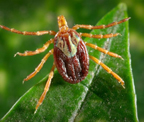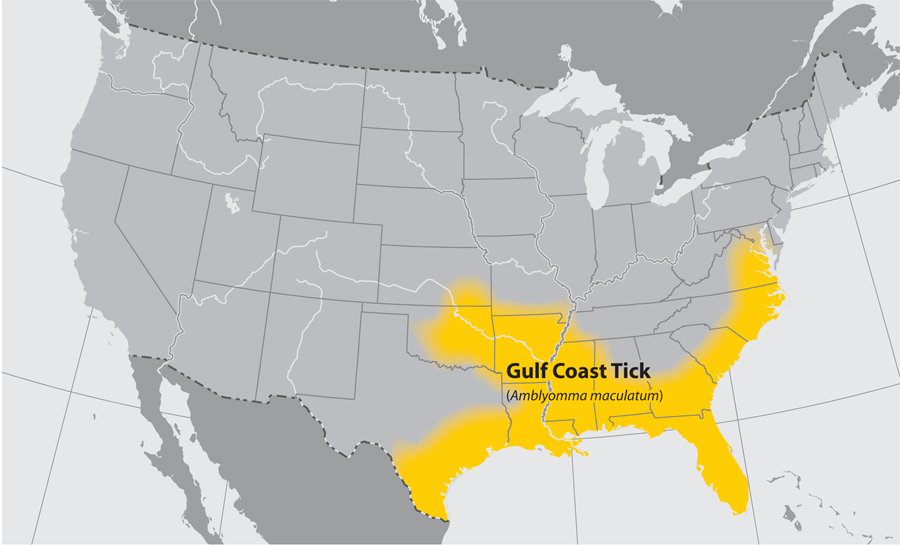Amblyomma maculatum
| style="background:#Template:Taxobox colour;"|Template:Taxobox name | ||||||||||||||
|---|---|---|---|---|---|---|---|---|---|---|---|---|---|---|
| File:Amblyomma maculatum.tif | ||||||||||||||
| style="background:#Template:Taxobox colour;" | Scientific classification | ||||||||||||||
| ||||||||||||||
| Binomial name | ||||||||||||||
| Amblyomma maculatum Koch, 1844 |
Editor-In-Chief: C. Michael Gibson, M.S., M.D. [1]
Overview
Amblyomma maculatum is a species of tick in the genus Amblyomma. Immatures usually infest small mammals and birds that dwell on the ground; cotton rats may be particularly favored hosts.[1] Some recorded hosts include:
- Geothlypis trichas[2]
- Cardinalis cardinalis[3]
- Passerina ciris[3]
- Sialia sialis[3]
- Thryothorus ludovicianus[3]
- Troglodytes aedon[3]
- Zonotrichia albicollis[3]
- Dog (Canis lupus familiaris)[3]
- Dama dama[4]
- Human (Homo sapiens)[2]
- Eastern woodrat (Neotoma floridana)[5]
- Odocoileus virginianus[4]
- Marsh rice rat (Oryzomys palustris)[6]
- Cotton mouse (Peromyscus gossypinus)[7]
- Hispid cotton rat (Sigmodon hispidus)[8]
- Pig (Sus scrofa)[9]
- Sylvilagus palustris[9]
In 2013, the infectious agent of American tick bite fever, Rickettsia parkeri was detected in a female A. maculatum collected at Bombay Hook National Wildlife Refuge, near Smyrna, Delaware, providing the first evidence of association of this pathogen of humans with this species of tick in the state.[10]
References
- ↑ Clark et al., 2001, pp. 1383–1384
- ↑ 2.0 2.1 Wilson and Durden, 2003, table 2
- ↑ 3.0 3.1 3.2 3.3 3.4 3.5 3.6 Wilson and Durden, 2003, table 1
- ↑ 4.0 4.1 Wilson and Durden, 2003, table 5
- ↑ Clark et al., 2001, table III
- ↑ Clark et al., 2001, p. 1381
- ↑ Clark et al., 2001, table II
- ↑ Clark et al., 2001, table IV
- ↑ 9.0 9.1 Wilson and Durden, 2003, table 4
- ↑ David A. Florin, Ju Jiang, Richard G. Robbins & Allen L. Richards. 2013. Infection of the Gulf Coast tick, Amblyomma maculatum (Acari: Ixodidae), with Rickettsia parkeri: first report from the State of Delaware. Systematic & Applied Acarology 18(1): 27–29; http://www.acarology.org/saas/saa/saa18/2013-18-027-029f.pdf.
Literature cited
- Clark, K.L., Oliver, J.H., Jr., Grego, J.M., James, A.M., Durden, L.A. and Banks, C.W. 2001. Host associations of ticks parasitizing rodents at Borrelia burgdorferi enzootic sites in South Carolina. Journal of Parasitology 87(6):1379–1386.
- Wilson, N. and Durden, L.A. 2003. Ectoparasites of terrestrial vertebrates inhabiting the Georgia Barrier Islands, USA: an inventory and preliminary biogeographical analysis (subscription required). Journal of Biogeography 30(8):1207–1220.
Gallery
- Common name: Gulf Coast tick
- Scientific name: Amblyomma maculatum
- Reservoir: birds and small rodents (larvae and nymphs); deer and other wildlife (adult ticks)
- Geographic distribution: coastal areas of the United States along the Atlantic coast and the Gulf of Mexico
- Disease transmitted: Rickettsia parkeri rickettsiosis
-
Gulf Coast tick (Amblyomma maculatum)
Adapted from CDC -
Approximate distribution of the Gulf Coast tick
Adapted from CDC

